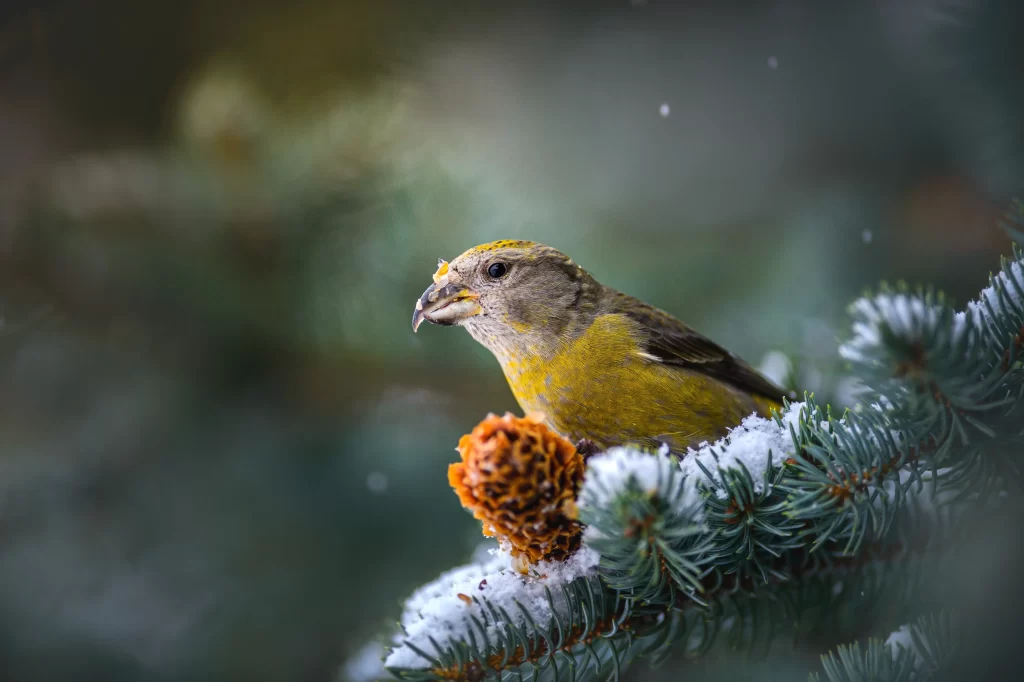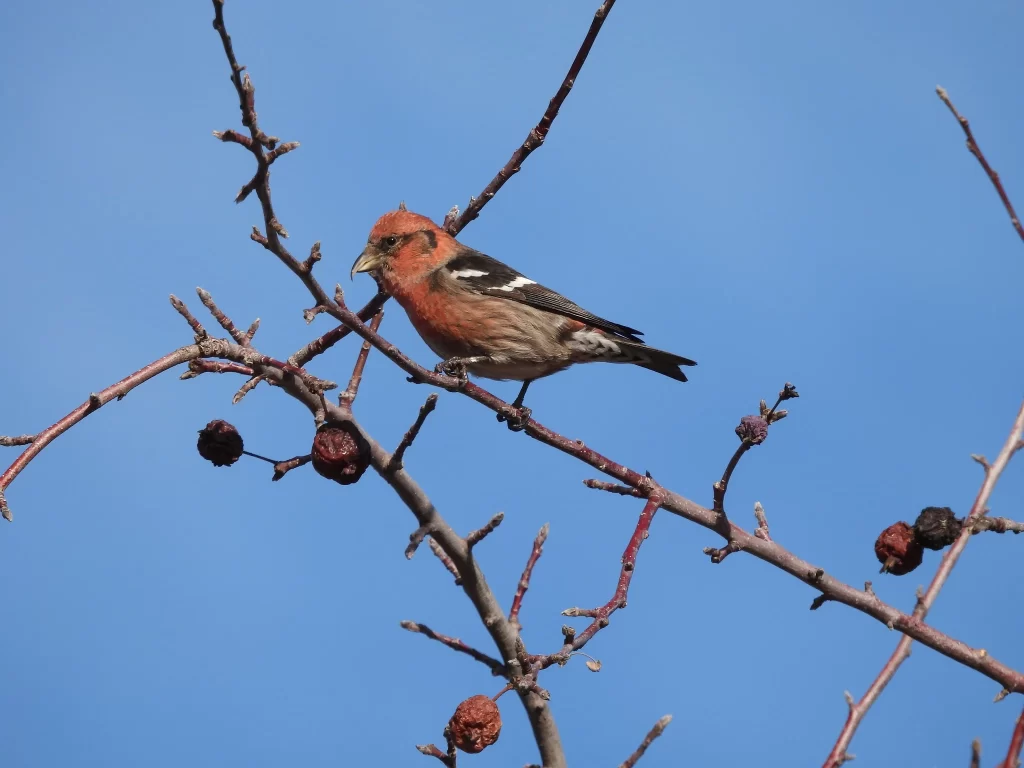Although the finches in Illinois are not as exciting as in places such as Michigan or western states, having 9 expected Illinois finches is still considerable. Some species of Illinois finch can be observed daily, while others are irregular and worthy of pursuit by birders.
If you’re interested in knowing more about the types of finches in Illinois, you’ve come to the right place! Please stick with me as I describe the variety of finches that can be observed in the state. Let’s learn about the finches of Illinois!
Table of Contents
9 Finches In Illinois
American Goldfinch

American Goldfinches are some of the most well-known birds in Illinois, and for good reason: they are the most numerous finch in the state as per eBird data. Indeed, there have been more than 630,000 reports of these yellow birds in Illinois on the popular birding site.
You’ll have a difficult time finding anyone who doesn’t adore goldfinches. Yes, these finch species in Illinois are beloved thanks to their lovely colors and charming, innocent demeanors. Furthermore, birders appreciate that they readily visit bird feeders to eat thistle or nyjer seed.
When not being viewed in a backyard, American Goldfinches will typically be found in groups as they travel around parks, ditches, and other locations that support weeds that grow the seeds that they love to eat.
Redpoll

Redpolls are uncommon yet regular winter finches in Illinois. There have been nearly 10,000 reports of this species as per eBird data, with the vast majority of reports made in the northern half of Illinois.
The best times to view these Illinois finches would be from November through mid-March. Afterwards, Redpolls depart for the Arctic tundra where they nest during the summer.
Redpolls are among the most social of the types of finches in Illinois, and they’re frequently observed in the company of other redpolls. Their small, conical bills are great at extracting seeds from a variety of plants. Look for them in parks, along lakeshores, and in fields overgrown with weeds.
European Goldfinch

Reports of European Goldfinches in Illinois during the 20th century were few and far between, but this species has been detected with increasing frequency in the state now that populations have apparently become established in some parts of the state.
Now, don’t expect European Goldfinches to become expected finches of Southern Illinois any time soon, as these birds are restricted to the northeastern portion of Illinois at this time. Nonetheless,
European Goldfinches have evolved to be migratory in this country, as there is evidence of them wintering in the Chicago suburbs before migrating north to breed in Wisconsin.
Placing a bird feeder in your yard and offering black oil sunflower seeds or thistle will provide the best chance for someone to view one of these finches in Northern Illinois. Additionally, they may be observed with groups of American Goldfinches, so keep an eye out for these exotic finches.
Evening Grosbeak

Evening Grosbeaks are one of the most desirable finches in Illinois. Not only are these birds beautiful, but they are rare in the Land of Lincoln, with only about 870 eBird records.
Evening Grosbeaks breed in the boreal forests of the Upper Midwest and Canada, but they occasionally wander into states such as Illinois in the winter. Therefore, late October through March is the best time to try for these dazzling finches of Illinois.
There are some years in which Evening Grosbeaks are more numerous compared to other years. Such years are known as irruption years, and such years see finches like Evening Grosbeaks travel south in greater numbers than usual as they search for food. Setting up a bird feeder is a tremendous way to attract Evening Grosbeaks.
House Finch

House Finches are the second-most numerous finch in Illinois according to eBird data, with about 400,000 observations being made. Despite their abundance, House Finches are not historically native to Illinois. Indeed, these red Illinois finches spread to the state after birds were released into New York less than a century ago.
House Finches are now a common sight in neighborhoods throughout Illinois, as they make their nests in shrubs, conifers, hanging pots, and many other artificial structures. Yes, House Finches have little fear of humans, and they’ll often be one of the most common birds in urban yards.
It’s important to learn how to distinguish a House Finch from a House Sparrow, as the two species look rather similar. However, those who feed birds will note that House Finches eat black oil sunflower seeds while House Sparrows do not tend to eat these treats.
Pine Siskin

Pine Siskins are common winter finches in Illinois, with most birds typically departing from the state by mid-May. However, some Pine Siskins may spend the summer in northern Illinois, and nesting has been confirmed in some areas.
Pine Siskins appear in substantial numbers come mid-October. These Illinois finches may be found in a variety of habitats including cemeteries, backyards, and parks. This Illinois finch is very social, and they’re not often found foraging by themselves.
The sharp-looking, conical bills of Pine Siskins are great for extracting seeds from pine cones. Although all of the other finches in Illinois are sexually dimorphic, male and female Pine Siskins look the same.
Purple Finch

There have been nearly 27,000 Purple Finch records in Illinois as per eBird data. This finch species in Illinois arrives in late September and strong numbers continue through winter into early May. There are occasionally summer records of Purple Finches.
Although Purple Finches look somewhat similar to House Finches, note that males are far more rosy in color, while females are paler with more extensive streaking. Listening for the clicking flight calls of these finches of Illinois is a great way to detect them.
Purple Finches love to eat berries during the nonbreeding season, so look for them at juniper groves, orchards, and cemeteries. They can often be found foraging at the edges of forests.
Red Crossbill

Red Crossbills are uncommon finches in Illinois, with about 1,600 records from the state. Some records span most of the year, but November tends to be the best time to find Red Crossbills in Illinois.
The best way to locate a Red Crossbill is by listening for its “jip-jip-jip” flight call. Although they are social, there are plenty of instances in which only a single Red Crossbill is observed.
Hoping that a Red Crossbill will stop by your bird feeders is not the best strategy for observing this Illinois finch. Instead, investigate cemeteries and other locations that support large pine or spruce trees. Here, these finches of Illinois use their intriguing bills to pry open pine cones and extract the seeds.
White-winged Crossbill

White-winged Crossbills are even more scarce than their red counterparts. Indeed, there have only been 1,300 reports of this species in Illinois, with most records coming from mid-October through May.
Neither of Illinois’s crossbills particularly enjoy visiting bird feeders, but White-winged Crossbills tend to be more likely to visit these structures compared to Red Crossbills.
These Illinois finches will be found frequenting many of the same habitats as Red Crossbills. However, it has been noted that White-winged Crossbills have a strong affinity for spruce cones. Finding a group of feeding crossbills is a thrilling sight, as these finches of Illinois are very acrobatic in their feeding habits – often dangling upside down from cones to extract seeds.

